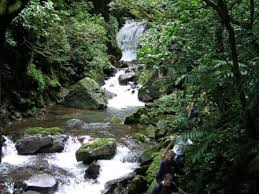Overview
An ecosystem is an assembly of everything that is in a particular area, both living creatures and nonliving elements. Some ecosystems, such as a square meter of forest, are dense with many different types of creatures and plants, while other ecosystems may be more sparsely populated. The different living organisms depend upon one another to survive, and their populations are in balance.
Habitat
The habitat of any plant or animal is the place where it generally lives. Some of the elements that make up habitat are from other living creatures that surround it. For example, a conifer tree may grow in a mountain forest. That tree is the habitat for the types of insects and birds that live around it, as well as the ferns, mushrooms, and mosses that grow in its shade. Not everything in a habitat is living, as other factors may include the climate, the soil, the amount of water that comes as rainfall, and the intensity of sunlight to drive photosynthesis.
Niche
The niche of any organism takes into account aspects such as its place in the food web, the nutrients it needs, how it gets what it needs, and what organisms feed on it. All living things also need particular physical conditions to survive. For example, many mosses must grow close to water, because they require water to reproduce. They thrive in wet areas such as bogs where the soil is moist year-round, and use the conditions to ensure their continued survival. Two species cannot be part of the same niche in exactly the same habitat at any one time, although similar species can be in similar niches. For example, different types of birds can nest in the same tree but in different areas, so they are not competing for the same resources.
Interactions
Living organisms interact with one another constantly. Sometimes competition is direct, as when two types of lizards try to catch the same insect. Some types of plants and animals are predators, while others are the prey. Some species live in a symbiotic relationship, so that either both species benefit, or one type benefits more than the other. For example, bees pollinate flowers, and flowers provide nectar as food for bees. Some types of parasites injure or kill the host, such as roundworms in the intestines of mammals.
Succession
Ecosystems do not remain static and unchanging, but change over time in response to different conditions. Suppose a volcano erupts, so that a flow of lava and ash covers the existing ecosystem. Around the mountain, such as what happened in the 1980 eruption of Mt. St. Helens. The lava erodes to rich volcanic soil from quickly growing mosses and lichens. Coarse grasses spring up through the soil, giving way to different types of trees and shrubs. Those trees and shrubs provide food for various types of small wildlife.
Interested in science tutoring services? Learn more about how we are assisting thousands of students each academic year.
SchoolTutoring Academy is the premier educational services company for K-12 and college students. We offer tutoring programs for students in K-12, AP classes, and college. To learn more about how we help parents and students in Williams Lake, BC: visit Tutoring in Williams Lake, BC




